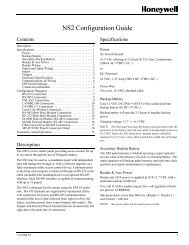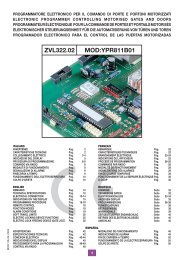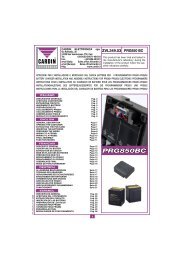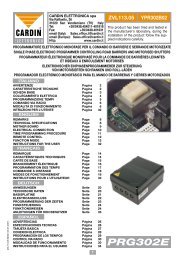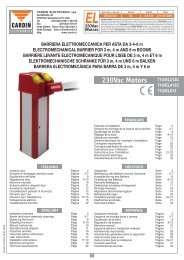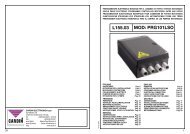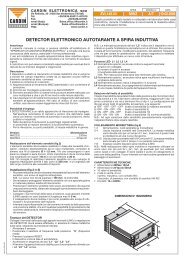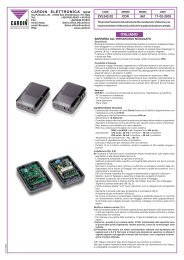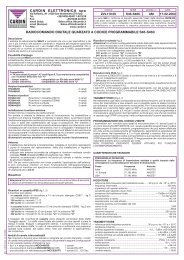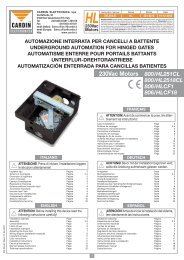1 - ADI
1 - ADI
1 - ADI
You also want an ePaper? Increase the reach of your titles
YUMPU automatically turns print PDFs into web optimized ePapers that Google loves.
4) Emergency manoeuvreIf the electronic programmer no longer responds to commands due to amalfunction you may use the EMRG1 or EMRG2 inputs to move gate leaf"1" manually. The EMRG1 and EMRG2 inputs directly command the motorrelays without passing through the logic control.Gate movement will be at reduced speed:Command EMRG1: OpensCommand EMRG2: ClosesAttention! During the emergency manoeuvre all safety devicesare disabled and there is no gate positioning control: release thecommands before you are at the mechanical travel buffer. Onlyuse the emergency manoeuvre in cases of extreme necessity.The electric lock (even if it is enabled) is not active. Therefore if anelectric lock is fitted it will have to be activated manuallyAfter you have carried out an emergency manoeuvre the electronic programmerwill lose the position of the gate leaf ( on the display) and thereforewhen normal operation is restored it will carry out an automatic repositioningmanoeuvre (see page 19).LIMITED OPENINGThis always effects gate 1; the limited opening space can be set (see displaymenu) to 1/3, half, 2/3 or the entire opening distance for gate 1. The commandcan only be carried out with both gates completely closed; if dip 1 isset to “OFF” and during opening you activate the “TAL” command againgate leaf 1 will block and when it receives the next command it will move inthe closing direction. At this point the command cannot be used again untilcomplete closure.• You cannot enter the programming mode when running off batterypower.Signal LEDs (page 6)L2: lit when the current supplied by the battery charger is greater than thebattery maintenance level (about 50 mA): battery under charge.L3: lit when the battery is not properly connected during blackouts.The wires connecting the battery to the charger card must neverbe short circuited, this would damage the battery, and in theworst of cases could lead to burns (if metal parts are touchingthe skin when the contact is made). Only connect them to theFaston (J1) and make sure you respect the polarity. If the batteriesare damaged they could leak acid.The batteries must only be installed/removed by qualifiedpersonnel. Used batteries must not be thrown into domesticrubbish bins and they must be disposed according to the localstandards and regulations in force.Battery checkMove the gate to the completely closed position and the display will switchoff. Check that LED "L2" (battery charging) is off.Switch off the power at the mains and make sure that the symbol appearson the display. Give a movement command and measure the overall voltagefor both batteries. The reading should be about 22 Vdc.COURTESY LIGHT /CH2 R<strong>ADI</strong>O OUTPUTBinding posts “9 ”,”10 ” are linked to a C-NO relay; this can be activated asfollows.• Jumper J5 in position 1: the contact is closed by a timer and works as a“courtesy light”• Jumper J5 in position 2: the contact works as a second radio channel.Binding posts “9 ”,”10” only give a potential free contact; this means that thecourtesy light will have to be powered by an external circuit and the contactused as a simple switch.BATTERY POWERED OPERATIONThis device allows devices connected to the electronic control unit to workduring blackouts.• To indicate that the programmer is working off battery power when thegate is completely closed a hyphen flowing around the perimeter ofthe display will appear. If the battery is under charged a hyphen flowingaround the lower half of the display will appear. When the battery isalmost completely flat the symbol will appear and the programmer willbe blocked.• When the gate is completely closed the controlled external devices (CTRL30 Vdc) do not receive power in order to increase the autonomy of thebattery. When a command is received however (via radio or via cable) theprogrammer sends power to the controlled external devices and checkstheir security status. It follows therefore that the command will be carriedout (security devices at rest) with a one second delay to give time to restorethe correct operation of the devices.If after this period a security device is found to be in alarm the commandwill not be carried out, power to the external devices will be cut off andthe programmer will return to stand-by.Attention! If you wish to use an external receiver it must be wired to bindingposts 16-17 (pag. 6) otherwise a command sent via radio will not be ableto activate the gate.• The self-sufficiency of the system when it is running on battery poweris dependent on the ambient conditions and on the load connected atbinding posts 16-17 (power is always routed there during blackouts).• The battery charge time with batteries in good condition can take up to amaximum of 15 hours. If the time required is greater you should considerreplacing the batteries. You are however advised to replace the batteriesevery three years.When the batteries are completely flat (during blackouts) theprogrammer will lose the position of the door and thereforewhen power returns carry out the repositioning procedure (seepag. 19). For this reason you should avoid leaving the electronicprogrammer without power for lengthy periods (more thantwo days).21



